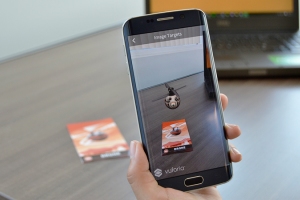PTC announces a major new release to Vuforia augmented reality platform

PTC announced the upcoming release of the newest version of its award-winning Vuforia® platform for AR development, Vuforia 7. Vuforia 7 will introduce major advancements in the ability to attach digital content to more types of objects and environments, and a new capability for delivering enhanced AR experiences on a wide range of handheld devices.
Vuforia is the world’s most widely used platform for AR development. With support for leading phones, tablets and eyewear, Vuforia has powered more than 475 million installs of AR apps from the App Store and Google Play. Vuforia Engine, the core of the platform, uses a device’s camera(s) and sensors to function as a digital “eye” inside an app. It “sees” objects and surfaces where content can be placed, and enables developers to create AR experiences using existing development tools.
Vuforia 7 will introduce Model Targets, a new feature for attaching content to objects that have not been recognisable using existing computer vision technology. Model Targets recognise objects by shape, in contrast to existing methods that rely on detailed visual designs typically found on print media, product packaging and many consumer goods.

Nathan Martz
With Model Targets, content can be attached to objects such as automobiles, appliances, and industrial equipment and machinery. Model Targets will enable a new class of AR content that can replace traditional user manuals and technical service instructions.
In response to tremendous developer demand, Vuforia 7 will also introduce a new capability for placing content on horizontal surfaces. Vuforia Ground Plane enables content to be placed on the ground, floor or tabletop, whether indoors or outdoors.
Vuforia Ground Plane extends the functionality of the Vuforia Smart Terrain feature, first announced in 2013 to take advantage of depth sensing cameras. Vuforia Ground Plane will support a wide range of today’s devices and provides an ideal solution for developers to build visualisation apps, ranging from in-home furniture shopping to design review.
Vuforia 7 will also introduce Vuforia Fusion, a new capability designed to provide the best possible AR experience on a wide range of devices. Vuforia Fusion solves the problem of fragmentation in AR-enabling technologies, including cameras, sensors, chipsets, and software frameworks such as ARKit and ARCore.
It senses the capabilities of the underlying device and fuses them with Vuforia features, allowing developers to rely on a single Vuforia API for an optimal AR experience. Vuforia Fusion will bring advanced Vuforia features to ARCore and ARKit-enabled devices, in addition to over 100 Android and iOS device models.
“We have worked with Vuforia since the original launch of Tango and we are excited to continue our partnership with the launch of ARCore,” said Nathan Martz, product manager, Google. “Vuforia will make it easy for developers to take advantage of ARCore in Vuforia features that developers are familiar with.”

Jay Wright
“If you’re a developer, there has not been a better time to get started with AR. It has never been easier with Vuforia now integrated in Unity. And there has never been the power to put your content in so much of the world,” said Jay Wright, president, Vuforia at PTC.
“Augmented reality is about making magic in the real world — bringing stories to life on a tabletop, a child’s playroom or in a forest,” said Tony Parisi, global head of VR/AR at Unity Technologies. “We’re pleased Unity developers have been able to create ground-breaking AR with Vuforia for a while now, and look forward to offering Vuforia 7 in an upcoming version of Unity. We believe this will allow creators to push the AR boundaries even further.”
Vuforia 7 will be available with support for ARKit in an upcoming Unity release. Vuforia Ground Plane will be included in Unity as part of a new free deployment option. Vuforia Engine SDKs are expected for Xcode, Android Studio, and Microsoft Visual Studio later this year. Support for ARCore is expected early next year.
Comment on this article below or via Twitter @IoTGN
